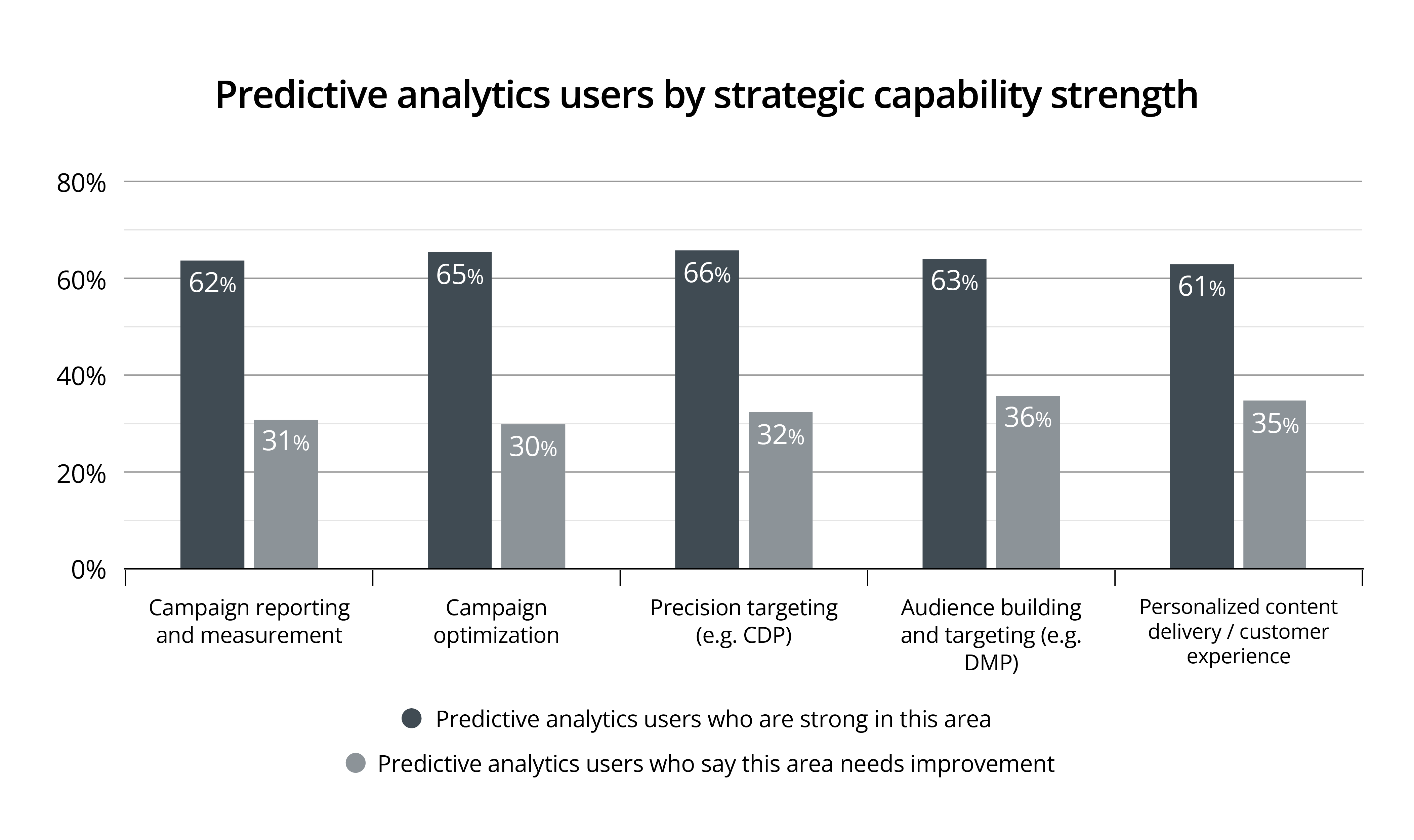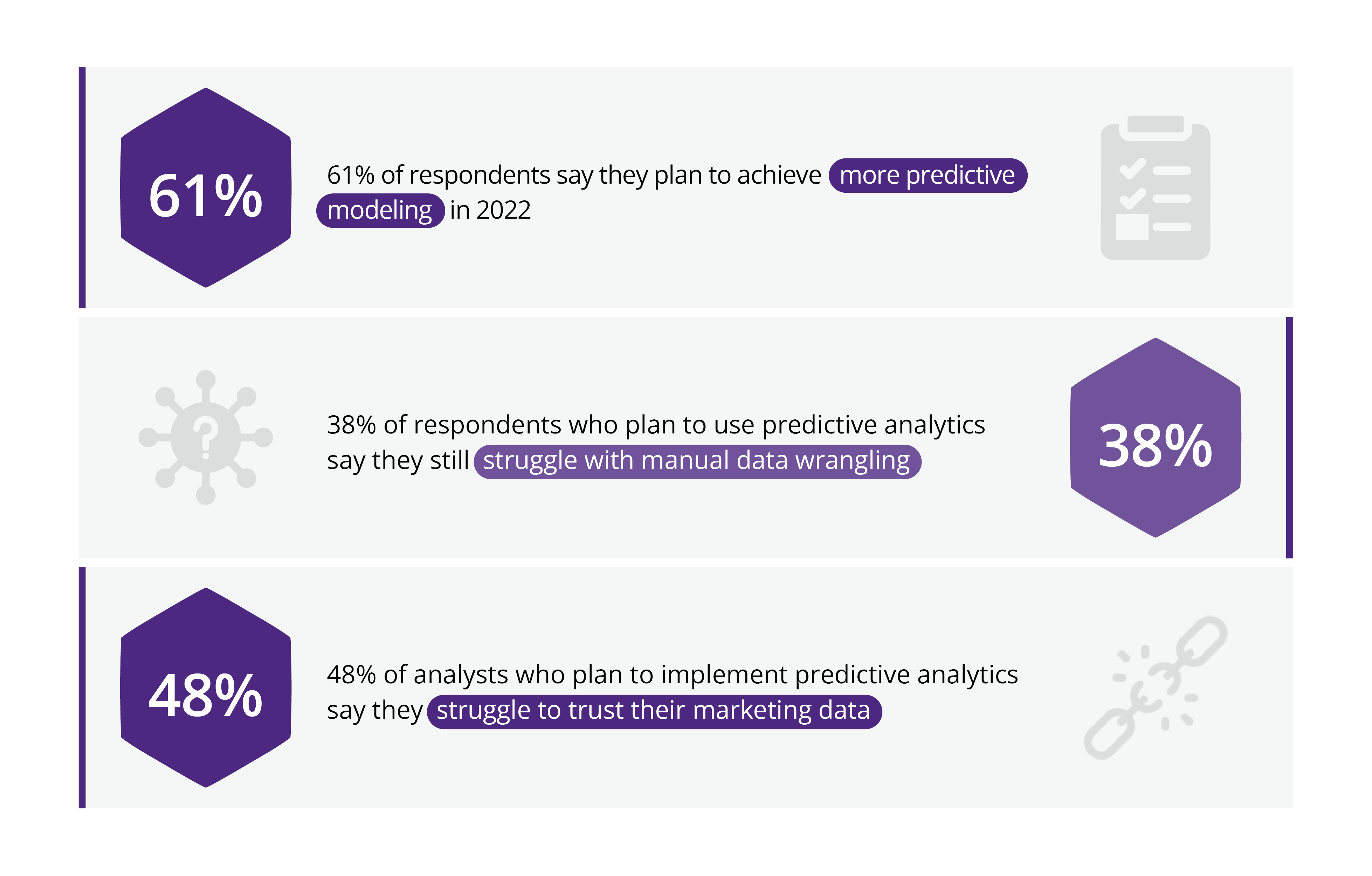According to our latest research, 61% of marketing teams aim to achieve predictive analytics in 2022. But are their martech stacks ready to take on this challenge? In this blog, we look at what businesses need to do in order to meet this goal and take their marketing strategy from reactive to proactive.
Patterns in customer behavior have been changing at the drop of a hat the past couple of years. Being able to predict trends and adapt optimizations as KPIs change has been crucial, and the demand for tech that can help marketing teams do this continues to grow. Subsequently, the predictive analytics market is growing by 23.2% a year. But before they dive headfirst into the world of predictive analytics, there are some key issues marketers must address.
Predictive analytics in a nutshell
For the uninitiated, predictive analytics allows marketers to take historical data, like revenue and budget spend, and use it to predict future performance. From there, they can make proactive optimizations, and build out strategies based on data rather than gut feeling.
- Predict campaign effectiveness and optimize accordingly
- Spot and target opportunities in high-potential markets and demographics
- Forecast and reduce churn rates
- Forecast media budget allocation at a total brand/campaign or channel level based on what is the most effective at achieving your KPIs
- Identify costly outliers like tanking CPC ahead of time
Did you know that 42% of CMOs say data hinders creativity?
Find out more in our latest report, "Data, People, and Culture: The Evolving Role of the Modern CMO"
The majority of marketers plan to have predictive analytics in 2022
Nearly two-thirds of marketing teams plan to introduce predictive analytics in 2022. Clearly, they see the value in it, and this spells out an exciting few years ahead.
“The world of marketing is approaching a tipping point, and in the next few years it’s likely we’ll see increasing amounts of companies moving their campaign optimization strategy from reactive to proactive.” Says Harriet Durnford-Smith, CMO of Adverity. “But it’s crucial that these organizations have the right data foundations in place to bolster this kind of advanced marketing technology.”
It’s crucial that these organizations have the right data foundations in place to bolster this kind of advanced marketing technology.
Harriet Durnford Smith, Chief Marketing Officer at Adverity
Predictive analytics can’t be implemented in a meaningful way unless marketing data is a) accurate, and b) integrated automatically. However, relatively few have passed this stage, and when it comes to getting insights from data, many marketing teams still depend on manual data processes.
Dos and don’ts for predictive analytics
Of the marketers and analysts we surveyed, half say they are currently using predictive analytics. What we’ve found is that these respondents are much more likely to have stronger strategic capabilities supporting a proactive marketing strategy.
Let’s take campaign reporting as an example. Respondents who have strong campaign reporting capabilities are twice as likely to be using predictive analytics than the respondents who say their campaign reporting needs improvement. Similarly, marketers and analysts who are good at campaign optimization are more than twice as likely to be using analytics.
What this tells us is that building out a strong set of marketing capabilities - particularly when it comes to reporting and optimization - will make the transition to using predictive analytics much more seamless.
DO: build out a strong set of marketing capabilities, especially around campaign reporting and optimization

Before you can run predictive models, you need to get all your data in one place. That’s step one. Technically, it’s not impossible to do this manually, but the amount of data that you need to integrate, and the complexity of that data, means that to run just one of these predictive models manually would eat into your analysts’ time in a big way. And if you’re looking for timely insights, then spending days inputting different data sources into a spreadsheet isn’t going to cut it. 38% of respondents who plan to implement predictive analytics say they still struggle with manual data integration.
Marketers who believe they can implement advanced data techniques such as predictive analytics whilst still relying on manual data wrangling and spreadsheets are living in a fantasy world.
Harriet Durnford Smith, Chief Marketing Officer at Adverity
“Marketers who believe they can implement advanced data techniques such as predictive analytics whilst still relying on manual data wrangling and spreadsheets are living in a fantasy world.” Says CMO of Adverity, Harriet Durnford-Smith.

On top of the timeliness issue, manual integration also opens the door for human errors. We’ve found that analysts who struggle with manual data integration are nearly four times as likely to struggle with low trust in data accuracy.
As the old adage goes, garbage in, garbage out. If your data isn’t accurate, the insights you get from it could end up doing more harm than good. However, nearly half of marketers and analysts who plan to introduce predictive analytics this year say they don’t trust their data. This is a major issue that needs to be addressed before marketing teams can get value out of predictive analytics.
DON’T: rely on manual data wrangling to run predictive models. It takes too long and introduces human error to your data
In short, predictive analytics without an automated single source of truth isn’t sustainable - especially if you want to factor predictive analytics into your long-term strategy.
So, it should come as no surprise that those with the tools to centralize and get a single view of data are much more likely to be running predictive models.
Of the respondents who say they have a central data lake or data warehouse, 69% use predictive analytics, for those who don't this falls to 27%.
Similarly, of the marketers and analysts who use a BI tool, 67% use predictive analytics, for those who don't this falls to 22%.
DO: Make sure you have the right tech to gain a single view of your marketing data
Want a single unified view of all your marketing data?
Speak to one of our advisors and find out how Adverity can help your business accelerate your marketing performance!



.png)







